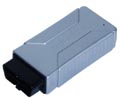- CAS Control module
- |
- BMW Electronic Systems
- |
- Technical Info
- |
- Car Tech Info
- |
- MicroTronik
Control module Car Access CAS

The CAS serves as an antitheft alarm system and enables the start of BMW vehicles.
A transponder chip is integrated in each of the vehicle keys. A ring coil is fitted about the ignition lock. The transponder chip is powered by this coil from the CAS control module. This means that no battery is necessary in the key. The power supply and data transfer take place in the same way as a transformer between the loop antenna (coil) at the ignition lock and the transponder chip.
The key then sends data to the CAS control module. If these data are correct, the CAS control module enables the starter by means of a relay located in the control module and additionally sends a coded start enable signal via a data link to the DME/DDE. These procedures may result in a start delay of up to half a second.
Data link to DME/DDE
The CAS control module sends a coded enable signal to the DME/DDE via the data link. The engine cannot be started before this signal has been transferred.
Engine control module (DME/DDE) with coded start enable input
The engine control module (DME/DDE) only enables engine start if a correct enable signal is received from the CAS control module.
EWS-DME/DDE interface
Identical random codes are stored in the CAS control module and in the DME/DDE control module. The value of these codes changes after every start procedure. Start enable only takes place if the code sent by the CAS control module agrees with the code calculated in the DME/DDE control module.
The control modules are allocated only during initial programming of the DME/DDE control module. The engine control module then adopts the basic code of the CAS control module.
Important Note:
It is not possible to replace the DME/DDE or CAS control modules for test purposes!
In rare cases, it is possible that the random codes in both control modules deviate from each other. In these cases, it is possible to reset both codes to the initial value via the service function (DME (DDE) - CAS calibration) (EWS calibration).
The following procedure takes place after inserting the vehicle key in the ignition lock:
· The transponder in the key is powered via the loop antenna and sends the key data to the CAS control module.
· The CAS control module checks the key data to ensure it is correct and only then sends an enable signal to the starter.
· The CAS control module sends the random code to DME/DDE. There, the random code is checked against the saved random code; if they match, the fuel injection is released.
· After the engine has started, the CAS control module generates new key data (random code) and transfers them to the transponder in the key.
· A new random code is also created and stored in the DME/DDE control module.
The following faults are monitored in the engine control module:
· Interface, i.e. line to CAS control module: In this case, the check is carried out in order to establish whether a signal is received and whether this signal is not subject to excessive interference.
· Random code: A check is conducted as to whether the random code which is sent by the CAS control module agrees with the value calculated in the DME (DDE) control module.
Engine start is inhibited if a fault is detected.
is one of the best Professional scan tools to for BMW; Autohex allows you to diagnose, code, program/flash ecus, and add new keys for BMW. For more information: BMW Scan Tool
Changing Dmaged DME in F Series


